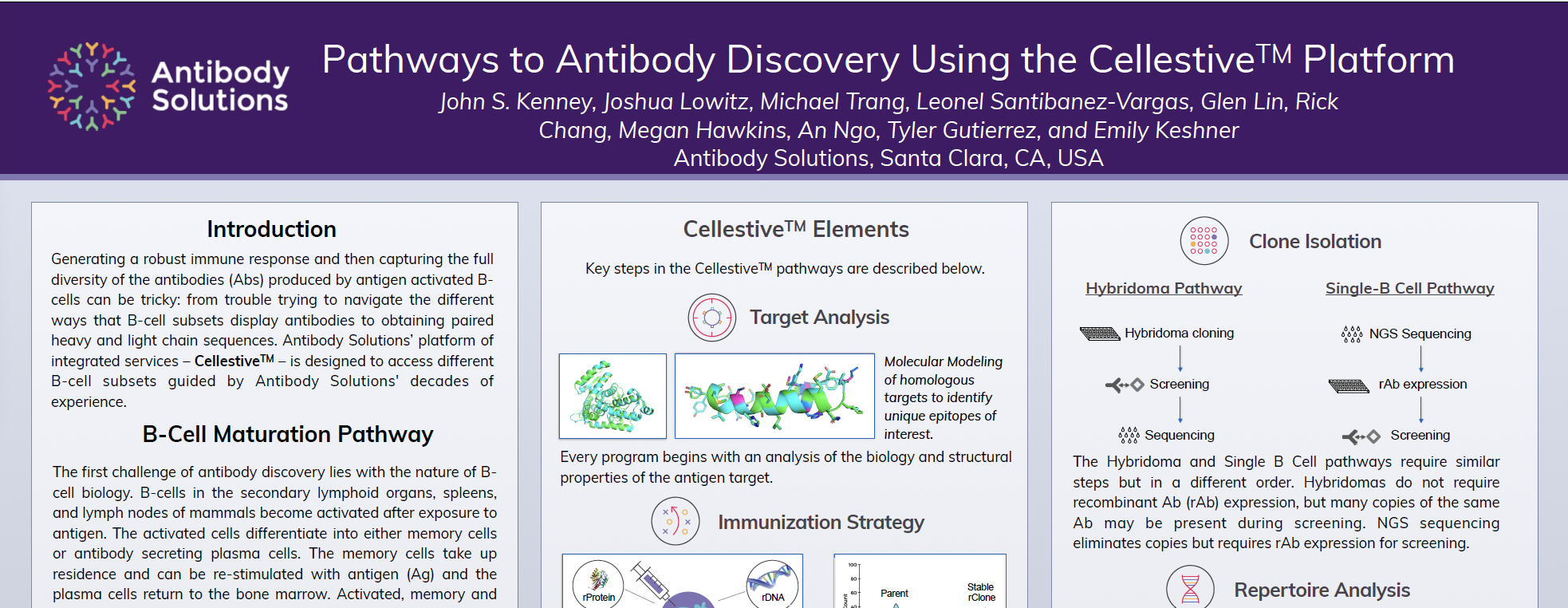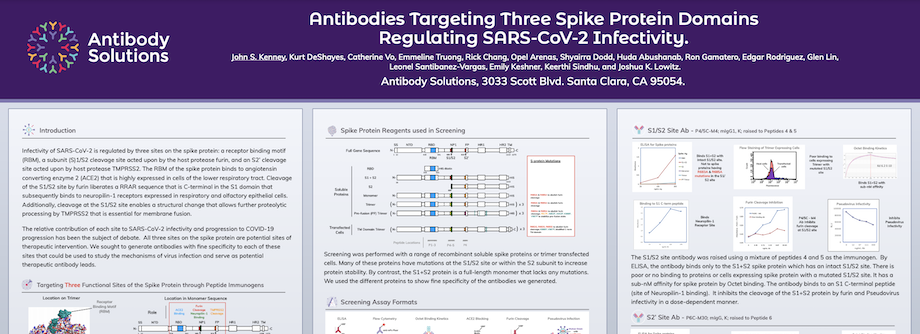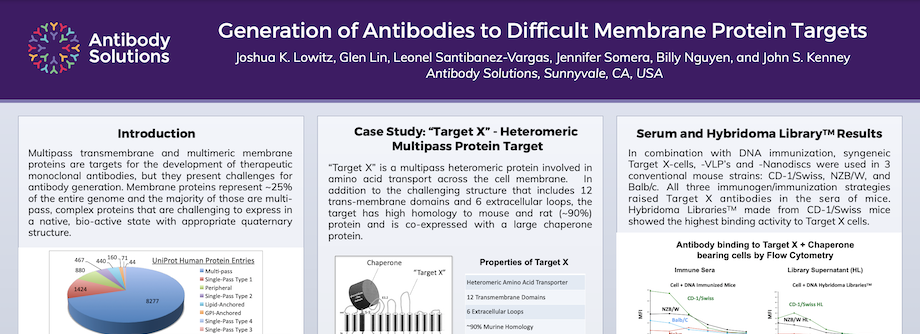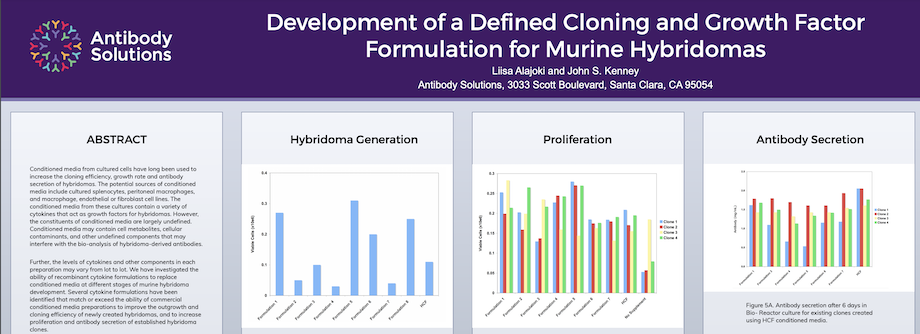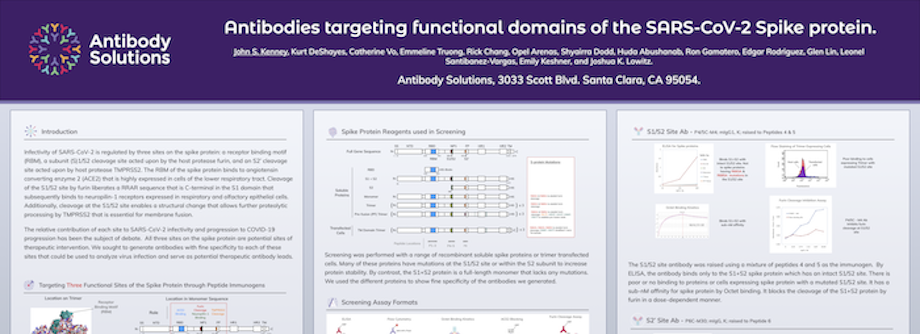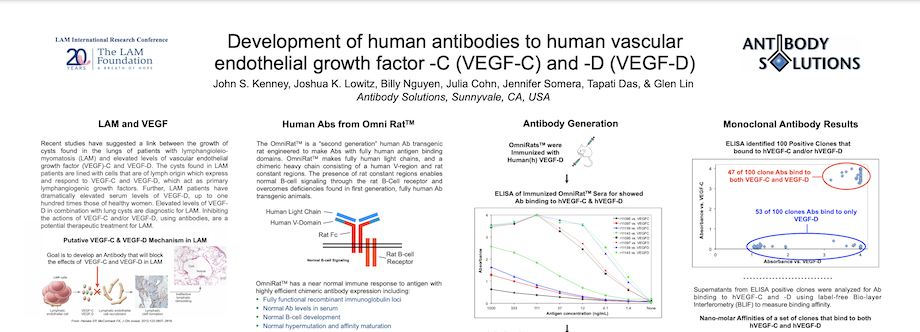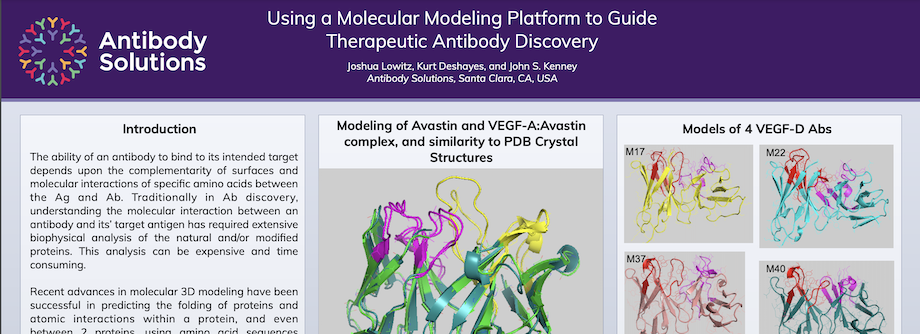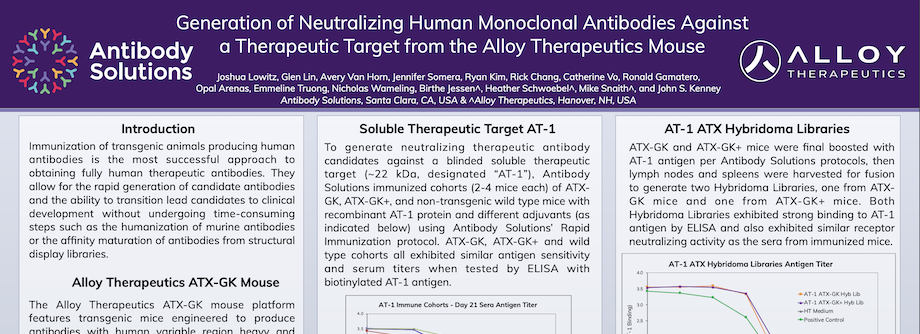
Antibody Solutions Research Team
Recent posts by Antibody Solutions Research Team
1 min read
Pathways to Antibody Discovery Using the Cellestive™ Platform
By Antibody Solutions Research Team on Nov 14, 2023 7:13:43 AM
CellestiveTM leverages the success of immune rodents in raising diverse and developable Abs. It can interrogate and isolate different B-cell populations using the same well-established technology (i.e., FACS), further enabling the diversity of Abs obtained.
Topics: Posters
1 min read
Discovery and characterization of prolactin neutralizing monoclonal antibodies for the treatment of female-prevalent pain disorders
By Antibody Solutions Research Team on Oct 5, 2023 11:19:20 AM
Prolactin (PRL) has recently been demonstrated to elicit female-selective nociceptor sensitization and increase pain-like behaviors in female animals. Here we report the discovery and characterization of first-in-class, humanized PRL neutralizing monoclonal antibodies (PRL mAbs). We obtained two potent and selective PRL mAbs, PL 200,031 and PL 200,039. PL 200,031 was engineered as human IgG1 whereas PL 200,039 was reformatted as human IgG4. Both mAbs have sub-nanomolar affinity for human PRL (hPRL) and produce concentration-dependent and complete inhibition of hPRL signaling at the hPRL receptor (hPRLR). These two PRL mAbs are selective for hPRL as they do not inhibit other hPRLR agonists such as human growth hormone or placental lactogen. They also cross-react with non-human primate PRL but not with rodent PRL. Further, both mAbs show long clearance half-lives after intravenous administration in FcRn-humanized mice. Consistent with their isotypes, these mAbs only differ in binding affinities to Fcγ receptors, as expected by design. Finally, PL 200,019, the murine parental mAb of PL 200,031 and PL 200,039, fully blocked stress-induced and PRL-dependent pain behaviors in female PRL-humanized mice, thereby providing in vivo preclinical proof-of-efficacy for PRL mAbs in mechanisms relevant to pain in females.
Topics: Monoclonal Publications Prolactin
1 min read
Capturing the Functional Antibody Repertoire from Multiple B-cell Subsets Following Antigen Stimulation
By Antibody Solutions Research Team on May 25, 2023 11:30:00 AM
B-cells are the original antibody display platform. Over time, they have proved to be the most reliable source of therapeutic antibodies. Capturing the full diversity of antibodies has been challenging due to how subsets of different b-cells display those antibodies and the ability to obtain paired heavy and light chain sequences. Our newly integrated platform of services – CellestiveTM – seeks to capture multiple functional B-cell subset repertoires using a flexible, comprehensive, and cost-effective approach.
Topics: Posters
1 min read
Antibodies Targeting Three Spike Protein Domains Regulating SARS-CoV-2 Infectivity
By Antibody Solutions Research Team on May 11, 2021 1:57:00 PM
Infectivity of SARS-CoV-2 is regulated by three sites on the spike protein: a receptor binding motif (RBM), a subunit (S)1/S2 cleavage site acted upon by the host protease furin, and an S2’ cleavage site acted upon by host protease TMPRSS2. The RBM of the spike protein binds to angiotensin converting enzyme 2 (ACE2) that is highly expressed in cells of the lower respiratory tract. Cleavage of the S1/S2 site by furin liberates a RRAR sequence that is C-terminal in the S1 domain that subsequently binds to neuropilin-1 receptors expressed in respiratory and olfactory epithelial cells. Additionally, cleavage at the S1/S2 site enables a structural change that allows further proteolytic processing by TMPRSS2 that is essential for membrane fusion.
Topics: SARS-CoV-2 Posters
1 min read
Generation of Antibodies to Difficult Membrane Protein Targets
By Antibody Solutions Research Team on Jan 5, 2021 1:24:00 PM
Multipass transmembrane and multimeric membrane proteins are targets for the development of therapeutic monoclonal antibodies, but they present challenges for antibody generation. Membrane proteins represent ~25% of the entire genome and the majority of those are multi-pass, complex proteins that are challenging to express in a native, bio-active state with appropriate quaternary structure.
Topics: Posters Multi-pass transmembrane Multi-meric Membrane Therapeutic Monoclonal Antibodies Antibody Generation
1 min read
Development of a Defined Cloning and Growth Factor Formulation for Murine Hybridomas
By Antibody Solutions Research Team on Jan 5, 2021 12:50:00 PM
Conditioned media from cultured cells have long been used to increase the cloning efficiency, growth rate and antibody secretion of hybridomas. The potential sources of conditioned media include cultured splenocytes, peritoneal macrophages, and macrophage, endothelial or fibroblast cell lines. The conditioned media from these cultures contain a variety of cytokines that act as growth factors for hybridomas. However, the constituents of conditioned media are largely undefined. Conditioned media may contain cell metabolites, cellular contaminants, and other undefined components that may interfere with the bio-analysis of hybridoma-derived antibodies.
Topics: Posters Hybridoma Conditioned Media
1 min read
Antibody targeting functional domains of the SARS-CoV-2 Spike protein
By Antibody Solutions Research Team on Jan 4, 2021 10:17:00 AM
Infectivity of SARS-CoV-2 is regulated by three sites on the spike protein: a receptor binding motif (RBM), a subunit (S)1/S2 cleavage site acted upon by the host protease furin, and an S2’ cleavage site acted upon by host protease TMPRSS2. The RBM of the spike protein binds to angiotensin converting enzyme 2 (ACE2) that is highly expressed in cells of the lower respiratory tract. Cleavage of the S1/S2 site by furin liberates a RRAR sequence that is C-terminal in the S1 domain that subsequently binds to neuropilin-1 receptors expressed in respiratory and olfactory epithelial cells. Additionally, cleavage at the S1/S2 site enables a structural change that allows further proteolytic processing by TMPRSS2 that is essential for membrane fusion.
Topics: SARS-CoV-2 Posters
1 min read
Development of human antibodies to human vascular endothelial growth factor -C (VEGF-C) and -D (VEGF-D)
By Antibody Solutions Research Team on Jan 1, 2020 1:49:00 PM
Recent studies have suggested a link between the growth of cysts found in the lungs of patients with lymphangioleiomyomatosis (LAM) and elevated levels of vascular endothelial growth factor (VEGF)-C and VEGF-D. The cysts found in LAM patients are lined with cells that are of lymph origin which express and respond to VEGF-C and VEGF-D, which act as primary lymphangiogenic growth factors. Further, LAM patients have dramatically elevated serum levels of VEGF-D, up to one hundred times those of healthy women. Elevated levels of VEGFD in combination with lung cysts are diagnostic for LAM. Inhibiting the actions of VEGF-C and/or VEGF-D, using antibodies, are a potential therapeutic treatment for LAM.
Topics: Posters VEGF-D Lymphangioleiomyomatosis LAM VEGF-C
1 min read
Generation Using a Molecular Modeling Platform to Guide Therapeutic Antibody Discovery
By Antibody Solutions Research Team on Dec 9, 2019 10:40:00 AM
"Using a Molecular Modeling Platform to Guide Therapeutic Antibody Discovery” details the integration of advanced 3-D modeling tools for the analysis of proteins and antibody-antigen interactions in our discovery platform. We show that adding molecular 3D modeling to the mix can reduce the cost and time of antibody discovery.
Topics: Transgenic Animals Posters Human Therapeutic Antibodies Immunization
1 min read
Generation of Neutralizing Human Monoclonal Antibodies Against a Therapeutic Target from the Alloy Therapeutics Mouse
By Antibody Solutions Research Team on Dec 9, 2019 10:31:00 AM
Immunization of transgenic animals producing human antibodies is the most successful approach to obtaining fully human therapeutic antibodies. They allow for the rapid generation of candidate antibodies and the ability to transition lead candidates to clinical development without undergoing time-consuming steps such as the humanization of murine antibodies or the affinity maturation of antibodies from structural display libraries.
Topics: Posters Monoclonal ATX-GX Alloy Therapeutics
Filter by Keyword
- Posters (21)
- Publications (15)
- Therapeutic Monoclonal Antibodies (4)
- Monoclonal (3)
- Multi-meric Membrane (3)
- Multi-pass transmembrane (3)
- Transgenic Animals (3)
- ELISAs (2)
- Human Therapeutic Antibodies (2)
- Hybridoma (2)
- SARS-CoV-2 (2)
- APOBEC3G (1)
- ARMER (1)
- ATX-GX (1)
- Alloy Therapeutics (1)
- Antibody Discovery (1)
- Antibody Generation (1)
- BRCA2 (1)
- CEM15 (1)
- Cadherin-11 (1)
- Carcinogenesis (1)
- Conditioned Media (1)
- Critical Reagents (1)
- Cystine Knot Peptides (1)
- D Protein (1)
- DLL4 (1)
- Fully Human (1)
- HIV-1 (1)
- HSA (1)
- IL-1 alpha (1)
- Immune B-cells (1)
- Immunization (1)
- Knottins (1)
- L-amino acids (1)
- L-selectin (1)
- LAM (1)
- LBAs (1)
- LOXL2 (1)
- Lymphangioleiomyomatosis (1)
- McAbs (1)
- OmniAb (1)
- OmniRat (1)
- PNAd (1)
- Pharmacokinetic (PK) (1)
- Prolactin (1)
- Secretion Capture Report Web (1)
- Stereochemistry (1)
- Therapeutic Targets (1)
- Tissue Culture (1)
- Transgenic H2L2 Mice (1)
- VEGF-A (1)
- VEGF-C (1)
- VEGF-D (1)
- p53 (1)


